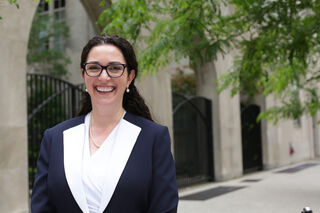Education
Want to Make an Impact? Try Lateral Mentoring
It's a form of mentoring that's highly accessible—and powerful.
Posted March 17, 2022 Reviewed by Hara Estroff Marano
Key points
- Look to your left, look to your right. Your next mentor might be next to you!
- Lateral mentoring comes naturally to us and arises organically.
- You are probably engaged in lateral mentoring and don't even know it!
When you think of mentoring, what do you envision?
Most people think of mentoring as a hierarchical arrangement: Find someone one or two levels higher than you to help guide you up the work ladder. Many have also heard of peer mentoring, an intentional one-on-one mentoring of employees (or often students) at the same level. There is a different type of mentoring, often overlooked, that is equally powerful: lateral mentoring.
This form of mentorship is generally not intentional. It isn't collaborating, deliberately working with someone to create or produce something. It isn't a pairing of individuals. It is, instead, organic. You are likely doing it and don't even know it. It is a form of mentorship we can engage in our whole lives, inside and outside of the work environment, and it often leads to high-impact outcomes.
Physicians engage in lateral mentoring all the time: A curbside consult, formal consult, and grand rounds often lead to lateral mentorship. How often have you stopped someone at work to ask for advice? In hospitals, physicians do this all the time. They just call it a consult.
We usually do not feel comfortable sharing our vulnerabilities with a boss or a hierarchical mentor, which makes sense because we want our standard-bearers and those opening doors to feel confident in our abilities. Trust is why a lateral mentor is so important. We need someone who isn’t our boss to whom we can say, “Hey can you give me some help with this problem?" "Can you give me some advice?”
The issue here is that we seldom acknowledge the support and guidance we receive from friends and coworkers. It just seems natural, so we don’t even realize we are engaged in lateral mentoring. We only engage when it is critical or we feel we really must ask for help. The interaction doesn't go as far as it possibly could.
Lateral Mentor in the Hospital

Sanjay Saint, MD, MPH, is the Chief of Medicine at the VA Ann Arbor Healthcare System and the George Dock Professor of Internal Medicine at the University of Michigan. Saint is a mentor’s mentor. He writes about mentoring, actively engages in mentoring, and works closely with a lateral mentor, Dr. Vineet Chopra. "I like the idea of lateral mentoring. Look left and look right, and you can learn from everyone and the superpowers that each of us has. I've used it without even knowing that that's what it is. I used it as an icebreaker with a new team of medical students and residents."
When he begins his block as an attending physician on a medical team, he uses an "icebreaker" to learn what each person's superpower is. Saint asks each of them on the initial day to say where they are from, what they want to learn from the time they have together, and other questions to help put them at ease. He also invites each person in the room to share their superpower or unique skill that makes them special. "You learn all kinds of things from these terrific doctors and doctors to be," says Saint. One intern said that he had memorized every line from the Lord of the Rings trilogy." And, of course, when tested, he could actually do it! "The idea of learning from everyone nicely morphs into mentorship," Saint observes.
Lateral Mentor in the Office

Dr. Ruth Gotian is the Chief Learning Officer and Assistant Professor of Education at Weill Cornell Medicine, and author of The Success Factor. She finds lateral mentoring to be free of guilt and expectation. "When a senior person is slightly out of reach, a peer, a friend, or a colleague, may be able to offer the guidance and support that is needed at the moment. Without guilt or expectation of anything in return, lateral mentors want what is best for you and believe in your ability and potential, often more than you believe in it yourself. They can help you talk things out and see a new perspective and potential in every challenge."
Gotian's lateral mentors "helped me enhance and tighten my writing, recommended marketing avenues for my new book on success, and helped me think bigger and bolder about opportunities. They removed my blinders and helped me overcome both overt and covert challenges. When I hit writer's block, they gave me the inspiration and sparked my creativity to forge ahead."
Lateral Mentor in Innovation

Bill "Ches" Cheswick is a retired innovator. He long worked for Bell Labs, a world-class research institution and the source of many inventions that you likely use daily. He described his work environment as a wonderland of lateral mentorship, with everyone working together. Everyone was working on inventions and if you needed help or had a problem you could just drop by someone's office and say "I have a problem with statistics. Can you help me?" And the answer was usually yes. Bill was working on the Internet’s Firewall, and he approached his colleague, Steve Bellovin, who taught him a lot that he didn't know. Together they co-authored the first book on firewalls, which has sold over 100,000 copies.
Lateral mentoring is an organic form of mentorship that allows the mentor and mentee to engage in a meaningful relationship that doesn't have expectations attached. It is not a tit-for-tat relationship but rather a generative relationship with both parties hoping to help the other without expectation of anything in return.
Take a look to your left. Now, look right. You are likely looking at a lateral mentor!




